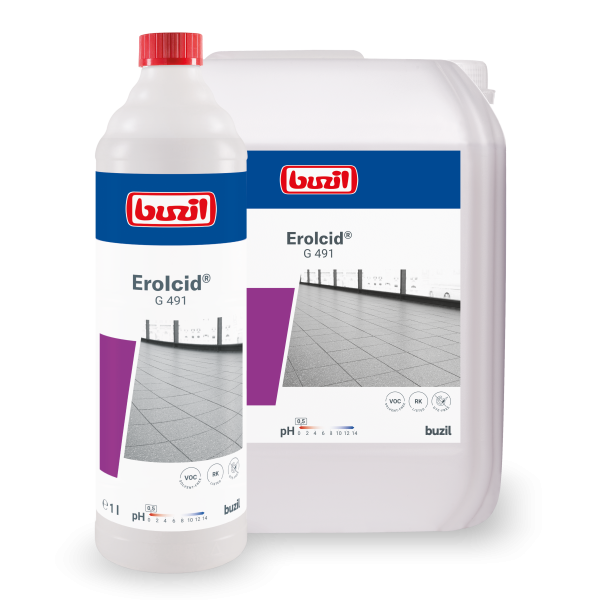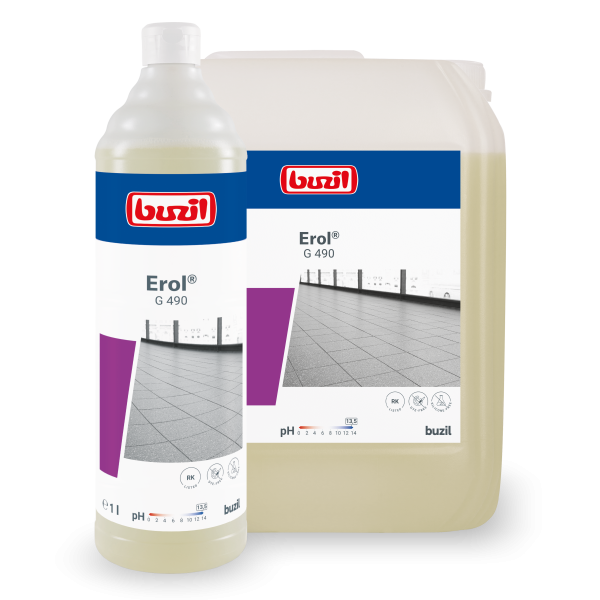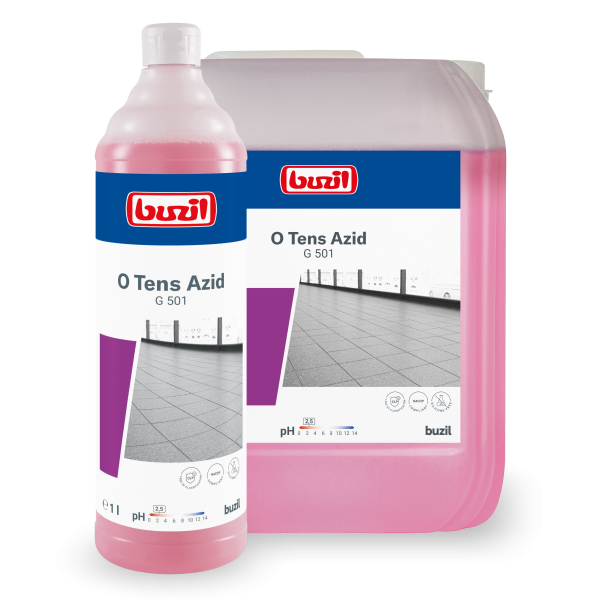Utilization
Soiling
-
Mineral soiling (lime, cement residue, urine scale, etc.)
Material compatibility
-
Ceramic tiles
-
Basalt
-
Stainless steel
-
Porcelain stoneware tiles
-
Safety tiles
Product Information
- Special cleaning agent based on phosphoric acid with fresh citrus fragrance
- Spontaneously and powerfully removes lime deposits, rust and cement residue
- A perfect cleaning result is achieved in the system with Erol® G 490
- RK-listed
Area of application
- for microporous, fine-rough and acid-resistant floor coverings, surfaces and materials, e.g. porcelain stoneware tiles and safety tiles
Application and dosage
- Always use cold water.
- In case of heavy foaming in the dirty water tank, Buz® Defoam G 478 can be used.
-
200 - 500 Millilitre / 10 liter Water
-
100 - 1000 Millilitre / 10 liter Water
-
100 - 1000 Millilitre / 10 liter Water
-
200 - 1000 Millilitre / 10 liter Water
- Apply fresh application solutions and consume them within 24 hours at the latest.
Note
- Pre-wet joints! Use only on acid-resistant materials.
- Rinse with clean water.
- Do not apply to lime-bound natural stones such as marble, Solnhofer slabs, travertine, shell limestone.
- Do not apply and mix together with chloric cleaners.
- When used in the machine, the tanks should be cleaned and rinsed regularly.
- Changes or variations in colour of the product do not impact on the quality. The product image may differ in colour and shape from the original.
Tips and tricks
Stripes and/or film on the surface
Rinse thoroughly with clean water
low / weak cleaning performance
Adjust product dosage
Surface damage (discoloration, swelling of material, etc.)
check chemical and water compatibility
Environmental Information
Proportion of easily degradable ingredients
98.2 %
Phosphorus content
69.9 mg/g
Palm oil-based raw materials - RSPO-certified share
100 %
The proportion of easily degradable ingredients refers to the proportion of organic ingredients that are defined as “easily biodegradable” according to OECD 301 or Detergent Regulation (EC) No. 648/2004. The value of the phosphorus content refers to elemental phosphorus. Palm oil is an important renewable source for the production of raw materials. The Roundtable on Sustainable Palm Oil (RSPO), founded in 2004, promotes sustainable cultivation methods for palm oil. This results in a certification system and the possibility of declaring raw materials as “RSPO-certified”.
Sales units
- G491-0010RA: 1 x 10 l canister
- G491-0001RA: 12 x 1 l bottle
- G491-0005RA: 1 x 5 l canister
Classification according to CLP
Danger marking
Danger
Hazard information
- H290: May be corrosive to metals.
- H314: Causes severe skin burns and eye damage.
Safety instructions
- P280: Wear protective gloves/protective clothing/eye protection/face protection.
- P301+P330+P331: IF SWALLOWED: rinse mouth. Do NOT induce vomiting.
- P303+P361+P353: IF ON SKIN (or hair): Take off immediately all contaminated clothing. Rinse skin with water or shower.
- P305+P351+P338: IF IN EYES: Rinse cautiously with water for several minutes. Remove contact lenses, if present and easy to do. Continue rinsing.
- P310: Immediately call a POISON CENTER/doctor.
- P501: Dispose of contents/containers in accordance with local and national regulations.
Download area
- Operating instructions
- Safety Data Sheets
- Technical Data Sheets
- Environmental Information





